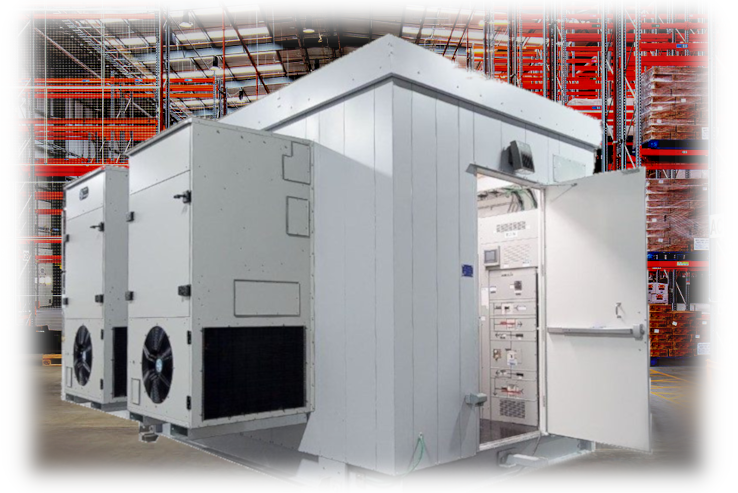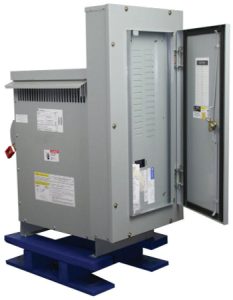In the fast-paced world of industrial operations, uninterrupted power supply is paramount for sustaining profit and productivity. Temporary power solutions play a crucial role in bridging the gap during power outages. During power outages, temporary power equipment skids are cost-effective, quick to deploy, and vital for overcoming an emergency power outage.
Among the components on a temporary power skid, Dry type general purpose transformers, sometimes called “Cast Resin Transformers,” are a mainstay component of temp power solutions for quick implementation, improved safety, and dependable power restoration. Dry transformers save production downtime, hedge against voltage fluctuations, and preserve delicate machinery by temporarily powering essential equipment. As a result, operations continue without interruption, financial losses are kept to a minimum, and ultimately, productivity and profitability are sustained in the industrial sector.
Need Temp Power For Your Project?
Get A Temp Power QuoteSell To Us
Got Electrical Equipment You Don't Need?

Reduce Your Electrical Inventories & Earn Cash
Sell My EquipmentPanelboard
Need a Panelboard for Your Project/Job?

Our Experienced Sales Engineers Can Help Design the Right Panelboard For You
Learn MoreTransformer Oil Testing
Is Your Transformer Due For Servicing?

Get Your Oil Analysis & Fluid Testing Done By Our NETA-Certified Techs
Learn MoreElectrical Product Resources
Product Training Product Safety Product Guides Product News Featured ProductsTemporary Electrical Power for Your Grid, Equipment Failures, Natural Disasters

The power supply of manufacturing facilities can be seriously interrupted by grid outages and blackouts, equipment malfunctions or failures, and natural disasters with severe weather. These unexpected events can cause serious disruptions, compromise industrial safety, halt operations and result in losses. That’s when temporary power solutions come into play, offering a crucial lifeline to maintain business operations when significant events happen, including:
Natural Disasters: The threat posed by natural catastrophes and extreme weather, such as hurricanes, floods, and storms, is significant for manufacturing plants. These occurrences have the possibility of severe damage to the electrical system, resulting in lengthy blackouts. A rapid and effective option to restore electricity to the facility is to use temporary power solutions, such as mobile power stations and temporary power distribution systems. Manufacturers may quickly recover from the effects of natural disasters and restore operations without experiencing severe delays by offering a dependable and adaptable power source.
Power Blackouts & Grid Failures: These have become more frequent as electrification increases, leaving manufacturing operations without electricity for hours or even days at a time. These power outages impact manufacturing processes and supply chains. Temporary power options, like mobile power units, transformers, and backup generators, provide a reliable alternate power source to reduce expensive downtime.
Equipment Failure: Another primary reason for power interruptions in manufacturing operations is equipment failure or malfunction. A single broken machine can stop an entire manufacturing line, impacting output and revenue. While repairs are being made, backup power is provided via temporary power solutions to keep vital equipment running. By doing this, manufacturers can maintain their production cycles and satisfy consumer requests with the least amount of disruption.
Power Outages Disrupt Profit and Productivity
A reliable power supply is essential for successfully operating manufacturing facilities’ advanced equipment and automated production lines. The unexpected power outage interferes with manufacturing procedures, causing delays in completing customer orders and missing delivery deadlines. Companies incur fines and lose business. Employees are paid for their unproductive time, and companies must pay for raw materials and inventory that can’t be processed or used while the system is down. The mix of missed sales, fines, and extra expenses significantly impacts the company’s bottom line.
Savvy industrial operators understand the need for temporary power solutions to avoid outages in the future. In order to maintain operations during electrical storms or other power-related events, they invest in transformers and backup generators and put in place a thorough power contingency plan. They reduce production downtime, safeguard revenue sources, and uphold customer satisfaction by implementing preventative actions.
Real-World Storm-Related Industrial Power Outages: Dry Transformers Deliver Temp Power
Example 1: MAJOR POWER OUTAGE DUE TO ELECTRICAL STORM
In 2019, a manufacturing plant in the Midwest experienced a significant power outage due to a severe storm that damaged the local power grid. The facility relied heavily on continuous power supply to operate its production lines and maintain critical systems. The sudden outage posed a significant threat to their productivity and profitability.

To mitigate the impact of the power outage, the plant had dry transformers as part of its backup power strategy. Dry transformers are a type of transformer that doesn’t require a liquid coolant such as oil. They are designed to provide a reliable power supply during emergencies and can be quickly connected to restore electricity to essential equipment.
When the power outage occurred, the plant’s maintenance team swiftly deployed the dry transformers to critical areas within the facility. Connecting the transformers to the backup power source could restore power to necessary machinery, enabling them to resume production quickly. This rapid response and utilization of dry transformers helped minimize downtime and prevent significant revenue losses.
Example 2: MAJOR POWER OUTAGE DUE TO ELECTRICAL GRID FAILURE
In 2020, a chemical processing plant in a coastal region experienced a sudden grid failure due to an electrical fault. The loss of power posed a significant safety risk and a potential threat to the integrity of the plant’s operations. The plant was equipped with dry transformers as part of its emergency preparedness plan.
During the grid failure, the dry transformers played a crucial role in maintaining essential processes and preventing hazardous situations. They provided temporary power supply to critical equipment such as pumps, ventilation systems, and emergency lighting, ensuring worker safety and minimizing the risk of chemical reactions or leaks.
Additionally, the dry transformers enabled the plant to initiate a controlled shutdown of non-essential operations, preventing damage to sensitive equipment and minimizing the potential for accidents. This strategic utilization of general purpose transformers helped protect the plant’s assets and prevented any environmental or safety incidents during the power outage.
In both examples, using dry transformers proved invaluable in mitigating the consequences of industrial power outages. These transformers offered a reliable and flexible power solution during emergencies, allowing for quickly restoring power to essential equipment. The manufacturing facilities could minimize downtime, protect worker safety, and prevent significant financial losses by employing dry transformers as a backup power strategy.
General Purpose Dry Transformer Maintenance Tips for Longevity and Efficiency
Visual Inspection
- Take time to visually inspect the transformer regularly
- Look for signs of damage, such as cracks, bulges, or discoloration
- Pay attention to loose or corroded connections and ensure that the enclosure is clean and free from debris.
Cleaning
- Keep the transformer clean by regularly removing dust, dirt, and debris
- Use a soft brush or compressed air to clean the surfaces, ensuring that ventilation openings are clear
- Avoid using water or liquid cleaners, as dry transformers do not have a liquid coolant
Insulation Resistance Testing
- Test the insulation resistance of the transformer periodically using a device like a Megger
- Helps identify degradation in the insulation and ensures it’s within acceptable limits
- Lower insulation resistance readings may indicate insulation issues that need attention
Temperature Monitoring
- Keep an eye on the temperature of the transformer
- Excessive heat can affect its performance and longevity
- Install temperature monitoring devices and ensure the operating temperature remains within the manufacturer’s recommended range
Tightening Connections
- Check and tighten electrical connections within the transformer regularly
- Loose connections can cause arcing or overheating
- See that all connections are secure – if you notice any loose or corroded terminals, tighten or replace them promptly
Protection from Moisture and Contaminants
- Prevent moisture ingress and contamination by ensuring proper enclosure seals and maintaining the ventilation system
- Moisture and contaminants can compromise the insulation and performance of the transformer
- Inspect and maintain the seals and ventilation regularly to keep the transformer protected
Professional Inspection and Maintenance
- Engage qualified professionals for comprehensive inspections and maintenance
- Schedule periodic professional assessments to ensure that the transformer is in optimal condition
- Professionals have the expertise to perform in-depth tests, identify potential issues, and recommend appropriate actions for long-term reliability
11 Temporary Power Equipment Components Every Facility Needs
| Temporary Electrical Power Equipment | Purpose |
| Dry Transformers | – Provide a temporary power supply during emergencies or when an alternative power source is required – Self-cooling design – eliminate the need for liquid coolants, such as oil – Can quickly and efficiently step up or step down voltage to meet specific electrical requirements in a temp power setup |
| Generators | – Provide electrical power during outages or in remote locations – Available in various sizes and fuel types (diesel, gasoline, natural gas) to meet different power requirements |
| Transfer Switches | – Transfer power between the main power source and the backup generator safely – Ensure a seamless transition and prevent electrical damage |
| Distribution Panels | – Distribute electrical power from generators or main power sources to various circuits and equipment within a facility – Provide control and protection for electrical distribution |
| Cables and Wiring | – Connect generators or power sources to distribution panels and equipment – Ensure the safe and efficient transmission of electrical power |
| Power Inverters | – Convert DC from batteries or other sources into AC for small-scale or mobile power applications, such as in vehicles |
| Battery Banks | – Store electrical energy in batteries for later use during power outages or off-grid scenarios – Provide a reliable and sustainable temporary power solution |
| Load Banks | – Simulate electrical loads to test and commission power systems – Ensure their proper functionality and performance before operation – Commonly used during installation or maintenance of power equipment |
| Voltage Regulators | – Maintain a stable voltage level by automatically adjusting and stabilizing fluctuations in electrical power – Protect sensitive equipment from damage caused by voltage variations |
| Surge Protectors | – Protect equipment from sudden voltage surges or spikes during power restoration/re-intro of power after an outage – Safeguard against electrical damage |
| Temporary Lighting | – Portable lighting solutions, such as work lights or string lights – Provide temporary illumination in areas affected by power outages or during construction and maintenance projects |
Storm season is approaching. Need Help Choosing a Temporary Electrical Power Solution? Contact one of our sales and service consultants today at 844.944.7372
